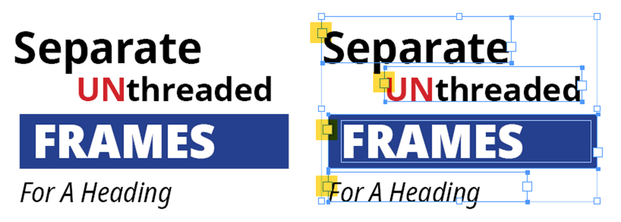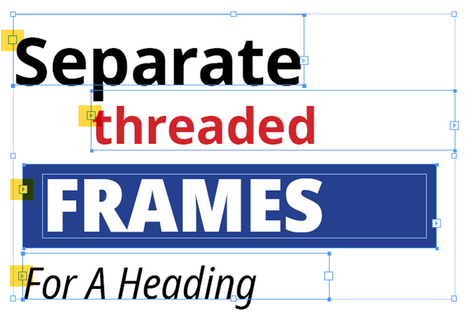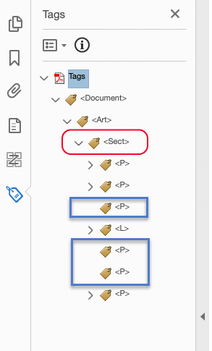- Home
- InDesign
- Discussions
- Re: Delete <sect> when exporting to PDF??
- Re: Delete <sect> when exporting to PDF??
Copy link to clipboard
Copied
Do you guys know a way to prevent InDesign from exporting content into a <sect> tag?
When exporting to a accessible PDF i have to manualy move tags out of the section tag = <sect> before deleting it, this is very time consuming process, but sometimes its necessary for the PDF to be accessible. -is there a way to stop indesign from exporting into a section tag??...maybe a script??
/Jakob

 2 Correct answers
2 Correct answers
Not sure why you think the <Sect> tag prevents your PDF from being accessible. It's a valid tag in the PDF/UA-1 standard (ISO 14289) and is used to denote a sub-section of a larger story. It's valid as shown in your screen capture as it denotes a section within the article tag <Art>.
That being said, you could have too many <Sect> tags in the exported PDF, or inapropriate use of them, and an accessibility officer or checker would flag that. This happens when your construction m
...The simple answer is you cannot do what you ask from Acrobat itself or through export settings. This is the way that InDesign creates tag structure for your content. I know you don't want to hear it and I completely understand. It frustrates me too. That is why I use third-party programs to remove those containers as part of my workflow. We call this flattening the tags tree. DM me if you wanna know the names of the ones I use. There are several out there. Be warned, None are cheap.
Copy link to clipboard
Copied
Not sure why you think the <Sect> tag prevents your PDF from being accessible. It's a valid tag in the PDF/UA-1 standard (ISO 14289) and is used to denote a sub-section of a larger story. It's valid as shown in your screen capture as it denotes a section within the article tag <Art>.
That being said, you could have too many <Sect> tags in the exported PDF, or inapropriate use of them, and an accessibility officer or checker would flag that. This happens when your construction methods aren't tight enough in the InDesign layout.
Essentially, InDesign produces a new <Sect> tag whenever a new story thread is created.
So one theory of document construction is to make sure that each story consists of a connected, threaded series of text frames from start to finish. Here's an example from my book that shows a multi-frame heading. Designers often do this type of construction when we want a different appearance of the heading's text, or we want to control alignment of each line. Note the open INports on each frame (in yellow) indicating a new "story."

And below is the resulting PDF. Note the 4 <Sect> tags, one for each unthreaded frame (or new "story").

A better way to accomplish a design like this is to either thread the frames together, or have only one frame and use formatting styles (paragraph and character) to create the visual appearance you want.
Below, the same frames are threaded into one story (note the blue arrows in the INports).

And the PDF has one <Sect> in the tags tree.

Hope this helps! Concentrate on better construction of the InDesign layout so that you have only appropriate, logical uses of the <Sect> tag.
And I noticed empty <P> tags in your screen capture (highlighted in blue below).
Those are caused by empty "returns" or paragraphs in your document, probably to create white space between paragraphs. You don't want blank paragraphs in an accessible document! So add space before/space after to your paragraph styles to create the white space and avoid the blank returns. Right now, those would need to be artifacted one by one in order to pass some accessibility checkers.

| PubCom | Classes & Books for Accessible InDesign, PDFs & MS Office |
Copy link to clipboard
Copied
Despite the previous answer, I would also like to have the opportunity to prevent sect-tags from being created on export. Connecting text frames might work for text-only content, but fails for me for content with a lot of pictures in between. If I anchor them within the text frames, the figure tags will be nested within p tags, which is semantically not correct (correct me if there is another solution to this). Therefor I would prefer to set the reading order with the article panel only and avoid the bloat of all those sect-tags around single p tags (even though they are technically valid there).
Copy link to clipboard
Copied
That requirement of PDF/UA-1 (that a <Figure> can't appear within a <P>) is totally inaccurate.
And I contest this when it's brought up in the PDF/UA committee (I'm a US delegate). There are plenty of valid conditions where a <Figure> can and should be nested inside a <P>.
With InDesign at this time, you have no option but to anchor <Figure> tags inside a <P> or other block-level element.
| PubCom | Classes & Books for Accessible InDesign, PDFs & MS Office |
Copy link to clipboard
Copied
Why do you think it's inaccurate? The only occasions in which I think figures are semantically correct when placed inline in p tags are icons or similar objects, that are unambiguously part of that line. However, any block figure, especially in combination with a caption, should not be 'inline' in my opinion. P tags should contain a paragrah of text content, shouldn't they? And the same way as one would avoid placing two paragraphs inside a single p tag, the same way I would avoid placing a paragraph and a text figure inside one p tag.
Copy link to clipboard
Copied
The simple answer is you cannot do what you ask from Acrobat itself or through export settings. This is the way that InDesign creates tag structure for your content. I know you don't want to hear it and I completely understand. It frustrates me too. That is why I use third-party programs to remove those containers as part of my workflow. We call this flattening the tags tree. DM me if you wanna know the names of the ones I use. There are several out there. Be warned, None are cheap.
Find more inspiration, events, and resources on the new Adobe Community
Explore Now
